Envelope And Efficiency: Meeting code requirements with insulated metal panels
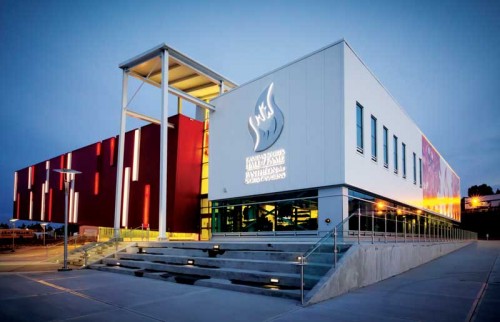
By Paul R. Bertram Jr., CSC, FCSI, CDT, LEED AP, and Ian J. Manser, LEED GA
Canada’s cold climate means building envelopes must be designed to properly address three main functions:
- support (i.e. dealing with the physical loads imposed on the building from gravity, wind, impact, and expansion/contraction);
- control (i.e. managing the flow of heat, moisture, air, light, and sound); and
- finish (i.e. esthetics of the building [interior and exterior], along with protection for other control and support elements).
Most traditional field-constructed assemblies require various trades to implement these three main functions. Some assemblies, such as insulated metal panels (IMPs), are factory-fabricated and installed as an integrated unit. (For more on these systems, see “Modelling Benefits with Insulated Metal Panels.”)
This article concentrates on Canadian code compliance considerations affecting the control functions of building envelopes, primarily heat flow through the building envelope. The updated National Energy Code of Canada for Buildings (NECB), (This code, in previous iterations, was known as the Model National Energy Code of Canada for Buildings [MNECB]). due out later this year, states the minimum requirements necessary to achieve a 25 per cent improvement over the 1997 code in the energy efficiency of newly constructed large buildings such as schools, hospitals, and apartment blocks. It takes into account the whole building system and incorporates a “trade-off” approach in each major area of building design. (For more information, see the article, “Canadian Buildings to Become More Energy-efficient,” posted on the Natural Resource Council (NRC) site. Visit www.nrc-cnrc.gc.ca/eng/news/nrc/2011/12/01/energy-code.html).
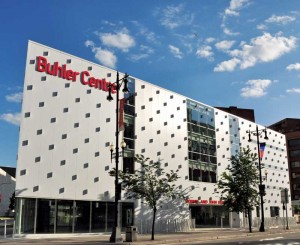
(25,000 sf) of insulated metal panels (IMPs). The reflective tabs on the façade reflect shifts of light, veiling over the exterior cladding; in summer, it resembles snow crystals.
Images courtesy Kingspan Insulated Panels North America
In July 2011, the Ontario Ministry of Municipal Affairs and Housing (MAH) issued an update to its SB-10 supplementary standard to the Ontario Building Code (OBC) that describes the energy efficiency requirements for projects seeking a building permit (effective January 2012). Building permit applications need to demonstrate compliance with SB-10 in one of three ways:
- meet American Society of Heating, Refrigerating, and Air-conditioning Engineers (ASHRAE) 90.1-2010, Energy Standard for Buildings Except Low-rise Residential Buildings, as modified by SB-10 Chapter 2;
- exceed ASHRAE 90.1-2010 by at least five per cent; or
- exceed 1997 NECB by at least 25 per cent. (Visit www.nationalcodes.ca/eng/public_review/2010/more_about.shtml).
Choosing the path
The 2011 NECB provides three pathways for envelope compliance, each one building on the previous in terms of flexibility and sophistication.
Prescriptive path
This option requires thermal evaluation of individual building envelope assemblies (i.e. walls, roofs, and floors) and comparison with tabulated requirements. This path offers the simplest, yet most rigid, choice for meeting code compliance.
The prescriptive path tabulates “overall thermal transmittance” (i.e. U-values) that “opaque building assemblies” (i.e. walls, roofs, and floors) must meet to comply with the code. These U-value requirements are based on the type of assembly and heating degree-days for the building location.
A location’s heating degree-days are based on a total of the daily difference between a baseline temperature (18 C [64 F]) and the location’s average temperature (on days when that temperature is below the baseline). This can be found using published tables or degree-day maps for the region in question.
Trade-off path
The trade-off path requires evaluation of the complete building envelope, adding greater sophistication to the calculations, but providing design flexibility through performance trade-offs between different envelope assemblies.
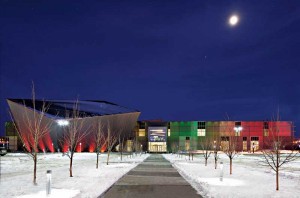
Performance path
Performance path allows the greatest design flexibility, since the energy consumption of all building systems (e.g. envelope, HVAC, lighting, etc.) are considered, and energy performance trade-offs are allowed between different systems.
Heat transfer and insulation
There are two primary mechanisms for heat transfer through a building envelope:
- conduction (energy through walls, roof, and foundation); and
- convection (air flow infiltration through gaps in the building fabric).
An energy-efficient building envelope design considers both these possibilities to reduce space heating and cooling costs.
Thermal insulation types and their application are critical design considerations. There are several design alternatives enabling a building envelope’s thermal performance to be optimized without compromising structural and esthetic requirements.
Typically, there are three alternatives for placement of insulation within building envelope assemblies:
- inside structural members;
- between structural members; and
- on the exterior of structural members.
A building assembly’s construction detail (including structural components, finishes, etc.) has significant effect on the assembly’s overall thermal transmittance value, and NECB requires these effects be included in any calculations provided for compliance purposes.

To maximize the thermal performance of any building envelope, good design stresses continuity of insulation by maintaining ‘continuous insulation’ values wherever possible. This is achieved through careful consideration of thermal bridging (i.e. short circuits) between areas of different temperatures caused by materials within the assembly with greater conductivity.
In most U.S. climate zones, ASHRAE calls for a layer of continuous insulation to be added to the assembly as a means of minimizing the effect of thermal shorts caused by more conductive structural members in standard assembly details that can decrease the energy efficiency of the wall system. Although this is not immediately relevant to Canada (i.e. NECB does not deal with the specifics of continuous insulation), this still indicates where the U.S. standard felt energy improvements could be made.
Continuity, U-values, and R-values
Per ASHRAE 90.1, continuous insulation must be continuous across all structural members without thermal bridges other than fasteners and service openings. It is installed on the interior or exterior or is integral to any opaque surface of the building envelope. Unfortunately, there is confusion on exactly what constitutes compliance with this. The definition is currently being reviewed by the 90.1 envelope sub-committee due to issues of code enforcement in the field.

Minimization of conductive heating and cooling losses are particularly important in Canada, given the often large temperature differences between the exterior environment and building interior. Diligent building element design and careful consideration of insulation materials can reduce these losses, and the subsequent energy costs of maintaining set interior environments. Considering the code requirements for overall thermal transmittance and evaluation of the effects of different materials within an opaque assembly’s design, it is important to clarify the differences between assembly U-values and material R-values.
Material R-value is the familiar insulation measurement value that indicates a material’s ability to resist the transfer of thermal energy for thermal resistance. Typically determined through testing (such as ASTM C 518, Standard Test Method for Steady-state Thermal Transmission Properties by Means of the Heat Flow Meter Apparatus), this information should be readily available from insulation material suppliers.
U-values, on the other hand, may be determined by assembly testing or two- or three-dimensional calculations that generally require use of finite-element computer modelling, depending on the complexity of the detail. While the rated R-value of an insulation material provides a means of evaluating an individual material’s thermal resistance, NECB prescriptive criteria is based on assembly U-values—that is, performance of the complete system.
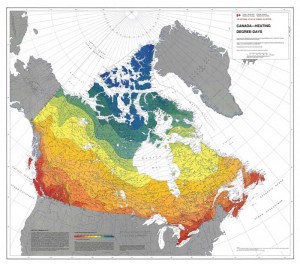
Image courtesy Natural Resources Canada
Assembly U-values are often determined using ASTM C 1363, Standard Test Method for Thermal Performance of Building Materials and Envelope Assemblies by Means of a Hot Box Apparatus, which measures heat transfer of full-scale (or typical/representative) samples of a building assembly at dictated temperature differentials. Although they provide a good estimation of the assembly’s thermal performance, the scale of the tested samples is often limited by available equipment at commercial test facilities and physical testing can become prohibitively expensive (particularly if there are a large number of assembly configurations that need to be evaluated).
The alternative to assembly testing involves estimating thermal transmittance values through various calculation methodologies (the complexity of which depends on the class of construction being evaluated). While certain construction assemblies can be adequately represented by relatively simple parallel-path or series calculations, most assemblies are sufficiently complex as to require two- or three-dimensional finite element modelling to adequately estimate performance.
There are numerous recognized programs, such as the list of modelling tools provided by Natural Resources Canada (NRCan) CanmetENERGY, that allow overall thermal transmittance calculations to be performed quickly (and at a relatively low cost, as compared to full-scale assembly testing through ASTM C 1363). (Visit canmetenergy.nrcan.gc.ca).
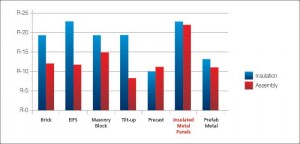
Images courtesy Kingspan Insulated Panels North America
Other paths
In lieu of meeting the prescriptive path requirements, compliance can also be achieved by using the available trade-off or performance paths.
The trade-off path considers the thermal performance of the entire building envelope. Individual assemblies that do not meet the prescriptive U-value requirements may be included, as long as the sum of building assembly components does not transfer any more energy than if they were all designed to meet the prescriptive requirements. This additional flexibility is important, particularly when dealing with certain conditions where the application of additional insulation is impractical, or interferes with the structural or esthetic design of the building.
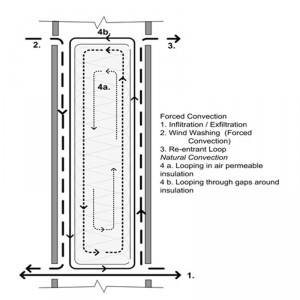
Thermal deficiencies in some areas of the envelope can be offset (i.e. traded-off) with other areas of the building, where application of additional thermal resistance may be more practical or cost-effective. It is important to note, however, this approach requires energy modelling of both the proposed and the reference (prescribed) building designs to demonstrate compliance.
The performance path provides a final envelope design alternative for code compliance in the event the assemblies do not satisfy the prescriptive requirements and there are no trade-off opportunities to balance energy transfer through the building envelope. The performance path compares more comprehensive energy models, including all the sections covered by the code (i.e. envelope, lighting, HVAC, service hot-water system, and electrical systems), and evaluates the modelled “annual energy consumption” of the proposed design to a “building energy target” based on the prescribed requirements for each section.
Similar to the trade-off method, the proposed design must demonstrate equal or less energy consumption than the energy target to meet compliance. This approach offers additional flexibility in application design, since trade-offs are not limited to one section, but with much greater analytical complexity (and cost).
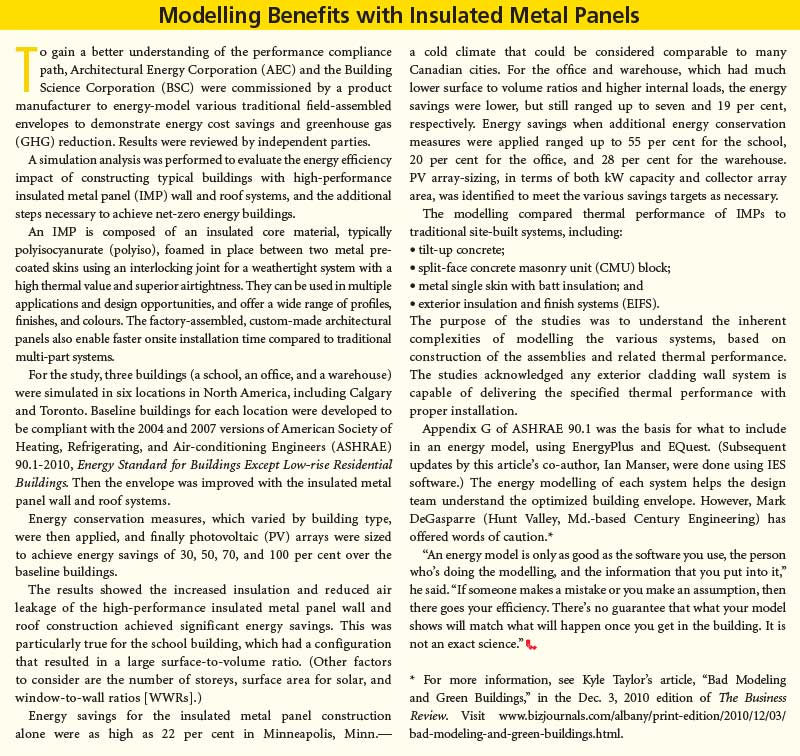 Conclusion
Conclusion
As design/construction professionals consider the National Energy Code for Buildings, it is important to start by evaluating the support, control, and finish functions of the envelope assembly to determine the optimized pathway for compliance.
Determining the location’s prescriptive requirements for each opaque building element, and specifying an insulation system that will satisfy the U-value criteria is critical. Construction details, of course, will affect the U-value performance.
As this article discusses, when a building envelope assembly design does not meet the tabulated, prescriptive requirements, the code allows for trade-offs in performance between other envelope assemblies or other building energy systems. The code also allows for calculations for demonstration of compliance. Sophistication (and cost) of calculations increase with compliance path choice, but so does design flexibility.
Paul R. Bertram Jr., CSC, FCSI, CDT, LEED AP, is the director of environment and sustainability for Kingspan Insulated Panels North America. He represents the company on various U.S. Green Building Council (USGBC), American Society of Heating, Refrigerating, and Air-conditioning Engineers (ASHRAE), ASTM, International Code Council (ICC), and National Institute of Building Science (NIBS) groups. Bertram is also the president of the Construction Specifications Institute (CSI) and a member of Construction Specifications Canada (CSC). He can be contacted via e-mail at paul.bertram@kingspan.com.
Ian J. Manser, LEED GA, is the North American manager for Kingspan’s energy services department. He has more than 18 years of experience working with industry experts and design professionals in the advancement of building energy conservation and generation. Manser can be reached at ian.manser@kingspan.com.







